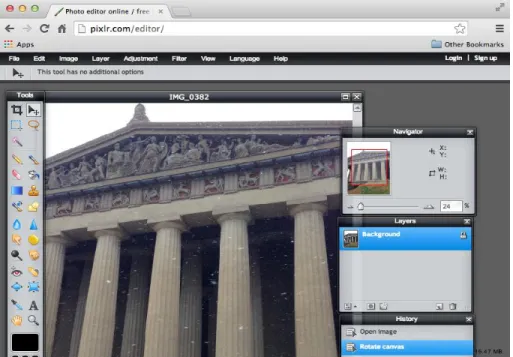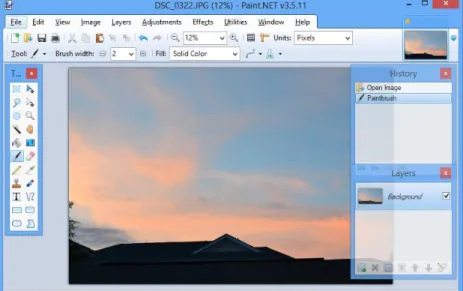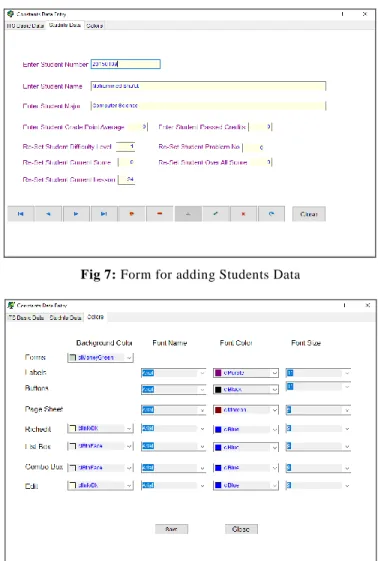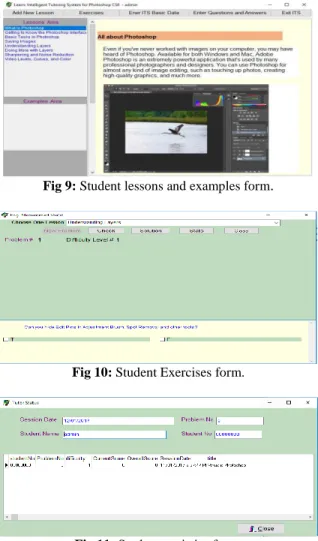International Journal of Academic Research and Development ISSN: 2455-4197, Impact Factor: RJIF 5.22
www.academicsjournal.com
Volume 2; Issue 1; January 2017; Page No. 81-86
ITS for
Photoshop
-
CS6
Mohammed Z Shaath, Mones Al-hanjouri, Rami ALdahdooh
Department of Information Technology, Faculty of Engineering & Information Technology, Al-Azhar University, Gaza
Abstract
In this paper, we designed and developed an intelligent tutoring system for teaching Photoshop. We designed the lessons, examples, and questions in a way to teach and evaluate student understanding of the material. Through the feedback provided by this tool, you can assess the student's understanding of the material, where there is a minimum overshoot questions stages, and if the student does not pass the level of questions he is asked to return the lesson and read it again. Eventually this administration is a special teacher for the students and can continue with him until he fully understands the lesson without weariness or boredom, regardless of the level of student.
Keywords:
intelligent tutoring system, authoring tool, ITSB,
photoshop, CS6
1. Introduction
The world recently has become technically advanced and not even one sphere is left untouched recently. Most people are using high-tech computer programs to try to do their work. One such program that helps them flip their work to master items is Adobe Photoshop. This user friendly tool could be a good way to ease your work method [3].
Certainly, there are numerous people that are using this software to get lots of money and also showing themselves in their own arenas. Therefore, it won’t be incorrect to days that learn Photoshop has also become the essential of the hour, regardless of your area of work. To persuade you in a better way, summed up here are certain of the reasons what everybody must learn Adobe Photoshop [1].
Photoshop is an art to set it in the meekest form. It is a method for an artist to slow himself or herself a s it can permit for the formation of an image which could never actually occur or take place. Photoshop is a tough program to study. A beginner user cannot just sit down and promptly be able to master the program in one day and generate some spectacular images. It takes years of training and improving of skills in order to make a bizarre Photoshop image [2].
Intelligent tutoring systems are instructive applications of machine learning and artificial intelligence technologies. Intelligent tutoring systems are intended to interrelate directly with students and do many of the instructional functions frequently earmarked for tutors or instructors. The systems have been used to show students in such varied domains as language, mathematics, law, physics, medicine, and reading comprehension [3].
An intelligent tutoring system is software intended to mimic a human tutor’s conduct and direction. Since these systems are talented to understand compound student replies and can absorb as they operate, they are gifted to distinguish where and why a student’s empathetic has gone amiss and to offer hints to aid the
tutors deliver numerous of the benefits of a humanoid tutor to huge numbers of students. Intelligent tutoring systems can too offer actual data to teachers and designers seeing to improve teaching methods [4].
2. Why Learn Photoshop?
One cause to study Photoshop is to just express yourself. You might want to be an artist but you might not be able to sit down there or need to sit there and paint on a canvas. Photoshop is the canvas of the forthcoming as it permits the freedom to prepare virtually everything you want with an image providing you have the skills to appeal it off and make it unalloyed quality.
It is a formula of expression since it permits a user to make an image any way they need and illustrate it in any way they need and then demonstrate it off to the world in a very cool and effective way as that image can then be used on numerous means. A Photoshop operator will produce a chic of his or her own and then use it every time they please and with complete options that the program deals, there really are no bounds to what can be done.
In addition to the form of expression Photoshop is similarly somewhat which can make you a countless deal of money in the upcoming. Photoshop is a talent which not very various persons have and one which can take a lengthy time to master. Consequently if you have this skill and you will go for an occupation that needs an artistic background of kinds then knowing Photoshop can place you bounds and confines above the rivalry.
A sample of this could be if you are employed for a marketing firm of kinds and you want to produce somewhat for a publicity campaign. The individual with the skills in something similar to Photoshop would be able to generate something far more multifaceted and professional-looking likened to somebody who may be a beginner at using Paint or alternative program.
Photoshop can aid in numerous ways as it can perform as a form of appearance, assist getting jobs, and even make
International Journal of Academic Research and Development
If you own the skills you can place them to work and add specific extra money in your pocket though at the same time getting the admiration of the Photoshop community and others who will admire you and seek to absorb the method and mastery which you have learned [2].
3. Photoshop CS6
Photoshop CS6, was released in 2012, added original artistic design tools and delivered a redesigned interface, with an emphasis on improved performance. Fresh features have been added to the Content-Aware device for example Content-Aware Move and the Content-Aware Patch.
Adobe Photoshop CS6 took a group of tools for video editing. Color and exposure adjustments, in addition to layers, are amongst some things that are contained in this new editor. Upon end of editing, the user is presented with a trickle of choices of transferring into a few general setups.
CS6 gets the "straighten" tool to Photoshop, where a user just draws a line anyplace on an image, and the canvas will reorient itself consequently that the line drawn turn out to be horizontal, and alters the media accordingly. This was made with the intent that users will draw a line parallel to a plane in the image, and reorient the image to that plane to more effortlessly attain convinced viewpoints.
CS6 permits background redeemable, which means that whereas another document is amassing and archiving itself, it is likely to concurrently edit an imag e. CS6 similarly features a customizable auto-save feature, stopping any work from being gone.
With the latest Photoshop version 13.1.3, Adobe has
released support for Windows XP (even on native x64 for Windows XP x64); therefore, the former version that works on Windows XP is 13.0.1. Adobe likewise proclaimed that CS6 will be the last group sold with continuous licenses in support of the new Creative Cloud subscriptions, but will endure to provision Photoshop CS6 for OS compatibility and will offer bug fixes and security updates as needed[1,2].
4. Photoshop Alternatives
Although Photoshop is a very powerful application, it's also very costly. There are numerous freeand low-cost applications that comprise tools similar to those found in Photoshop. You can acquire more around several of the most common Photoshop alternatives underneath.
Have in mind that no one of these applications will contain all of the topographies found in Photoshop. Despite the fact that you may be capable to use one of these applications to keep an eye on along with the remaining of this, it's significant to note that several of the features we'll deliberate may be absent or work in a diverse way.
If you only want to create simple alterations to your photos, such as resizing and cropping, you may need to attempt using a supplementary basic image editor [2].
4.1 Pixlr
The Pixlr Editor is a free software that runs in web browser. It contains numerous advanced features and in numerous ways is like Photoshop. For rapid edits, Pixlr also has a simple version called Pixlr Express, which is also obtainable as a mobile app [2].
Fig 1: Pixlr Editor application
4.2 Paint.NET
Initially designed as an open-source alternate to Microsoft Paint, Paint.NET now it contains some
advanced editing tools. Though it only offered for Windows [2].
Fig 2: Paint.NET Editor Application
4.3 GIMP
Intended as an open-source alternate to Photoshop, GIMP is freetouse on both Windows and Mac. While it's a powerful application, you might
discover the interface unclear and hard to use if you aren't somewhat aware with other image editing software [2].
Fig 3: GIMP Editor Application
5. Literature Review
Various Intelligent Tutoring Systems(ITS) were developed for: learning Computer Theory [16], e-learning system [22], ADO-Tutor: leaning ADO.NET [17], parameter passing in Java programming [25], predicting learners performance using NT and ITS [30], CPP-Tutor for C++ Programming Language [28], a comparative study between Animated Intelligent Tutoring Systems (AITS) and Video-based Intelligent Tutoring Systems (VITS) [24], stomach disease Intelligent Tutoring System [15], diabetes [14], Computer Networks [13], teaching DES information security algorithm[18], Mathematics Intelligent Tutoring System [34], C# Language [9], effectiveness of e-learning [7, 32], effectiveness of the CPP-Tutor [23], teaching AI searching algorithms [33], teaching database [27], teaching the 7 Characteristics for Living Things [19], teaching the
Health problems related to addiction of video game playing [10], teaching advanced topics in information security [21], Oracle Intelligent Tutoring System (OITS) [11], Learning Java Objects[6], teaching grammar English tenses [12], Java Expression Evaluation [5], Linear Programming [26, 29, 30], teaching Mongo Database [20].
International Journal of Academic Research and Development
6.1 Knowledge base model
This component is synonymous with the domain model of other architectures. A domain model is a system of abstractions that describes selected aspects of a sphere of knowledge, influence. The model can then be used to solve problems related to that domain. The domain model is a demonstration of expressive real-world ideas relevant to the domain that want to be modeled in software. The ideas contain the data tangled in the business. Business uses in relation to that data.
A domain model usually uses the terminology of the domain so that a demonstration of the model may be used to interconnect with non-technical stakeholders.
6.2 Student model
A core model demonstrating cognitive processes (such as information retrieval, problem solving, and calculation), meta-cognitive approaches (e.g., learning from errors) and psychological qualities (learning style, developmental level, and interests) are upheld for each student.
6.3 Pedagogical module
This model is similar to its complement the tutoring model in other architectures. It uses a model of the student's present comprehension to select an effectual path through its knowledge representation to produce expert conduct by the student. It uses different teaching approaches on the foundation of a developing student model, and an fundamental instructional theory that controls which pedagogical means is best well-organized to achieve a given end, other approaches to dialogue organization (regulating to diverse learning styles), and domain-dependent coaching heuristics. A teaching model is suggested to ease integration and co-ordination of the tasks of the other modules.
6.4 User interface
This module integrates three kinds of information that are required in carrying out a dialogue: knowledge about student and action within dialogues; domain knowledge desired for interacting content; and knowledge wanted for interconnecting intent. The model architecture makes an amount of significant offerings in that it: includes a distinct user interface constituent; exemplifies cognitive methods, meta-cognitive schemes and learning panaches in student model; and contains domain dependent instruction heuristics in the pedagogical model, all of which are previously unspecified. The user interface is stared as an inner and integral constituent of the ITS architecture while other architectures watched this constituent as external to an ITS. This presence has optimistic penalties in that user-interface enterprise and usability subjects have develop part of ITS growth apprehensions. Another significant influence is the use of a pedagogical component, which syndicates instructional theory with pedagogical plans and dialogue organization for as long as instruction to students. This architecture was invented as traditional in that it developed the manufacturing standard for ITS building (See Figure 5-Figure 11) [31].
Fig 5: Student Login Form.
Fig 6: Form for adding ITS Basic Data.
Fig 7: Form for adding Students Data
Fig 9: Student lessons and examples form.
Fig 10: Student Exercises form.
Fig 11: Student statistics form.
7.Evaluation
We presented System on some specialists in the field and it was applauded by some, while others request to improve the system and increase the lessons, questions, and exercises, but it is a good idea for the educational material, which makes it easier for students to understand their lessons and follow-up at any time they want.
8.Conclusion
Through what has been reviewed we have created a simple way to explain the material instruction using intelligent tutoring system, while ensuring that the student take advantage of through the questions and find solutions for those who could not answer them. The results of preliminary evaluation of our system were satisfactory.
In the future, we will increase the lessons to cover a greater range of educational material and make it simpler.
References
1. Akkila, A. N. and S. S. Abu Naser (2017). "Teaching the right letter pronunciation in reciting the holy Quran using intelligent tutoring system." International Journal of Advanced Research and Development 2(1): 64-68. 2. Abu Hasanein, H. A. and S. S. Abu Naser (2017). "An
intelligent tutoring system for cloud computing.".
3. Abu Naser, S. (2008). "An Agent Based Intelligent Tutoring System For Parameter Passing In Java Programming." Journal of Theoretical & Applied
Information Technology 4(7).
4. Abu Naser, S. S. (1999). "Big O Notation for Measuring Expert Systems complexity." Islamic University Journal Gaza 7(1): 57-70.
5. Abu Naser, S. S. (2001). "A comparative study between animated intelligent tutoring systems AITS and video-based intelligent tutoring systems VITS." Al-Aqsa Univ. J 5(1): 72-96.
6. Abu Naser, S. S. (2006). "Intelligent tutoring system for teaching database to sophomore students in Gaza and its effect on their performance." Information Technology Journal 5(5): 916-922.
7. Abu Naser, S. S. (2008). "Developing an intelligent tutoring system for students learning to program in C++." Information Technology Journal 7(7).
8. Abu Naser, S. S. (2008). "Developing visualization tool for teaching AI searching algorithms." Information Technology Journal, Scialert 7(2): 350-355.
9. Abu Naser, S. S. (2012). "A Qualitative Study of LP-ITS: Linear Programming Intelligent Tutoring System." International Journal of Computer Science & Information Technology 4(1): 209.
10. Abu Naser, S. S. and I. S. Zaqout (2016). "Knowledge-based systems that determine the appropriate students major: In the faculty of engineering and information technology." World Wide Journal of Multidisciplinary Research and Development 2(10): 26-34.
11. Abu Naser, S. S. and S. H. ALmursheidi (2016). "A Knowledge Based System for Neck Pain Diagnosis." World Wide Journal of Multidisciplinary Research and Development (WWJMRD) 2(4): 12-18.
12. Abu Naser, S. S., et al. (2008). "A Proposed Expert System For Guiding Freshman Students In Selecting A Major In Al-Azhar University, Gaza." Journal of Theoretical & Applied Information Technology 4(9).
13. Abu Naser, S., et al. (2011). "Human Computer Interaction Design of the LP-ITS: Linear Programming Intelligent Tutoring Systems." International Journal of Artificial Intelligence & Applications (IJAIA) 2(3).
14. AbuEloun, N. N. and S. S. Abu Naser (2017). "Mathematics intelligent tutoring system." International Journal of Advanced Scientific Research 2(1).
15. AbuEl-Reesh, J. Y. and S. S. Abu-Naser (2018). "An Intelligent Tutoring System for Learning Classical Cryptography Algorithms (CCAITS)." International Journal of Academic and Applied Research (IJAAR). 16. Abu-Naser, S. S. (2008). "JEE-Tutor: An Intelligent
Tutoring System for Java Expression Evaluation."
17. Abu-Naser, S. S. (2016). "ITSB: An Intelligent Tutoring System Authoring Tool." Journal of Scientific and Engineering Research 3(5): 63-71.
18. Abu-Naser, S., et al. (1995). "& Beattie, GA (2000)." Expert system methodologies and applications-a decade review from: 9-26.
19. Abu-Naser, S., et al. (2011). "An intelligent tutoring system for learning java objects." International Journal of Artificial Intelligence and Applications.
20. Alawar, M. W. and S. S. Abu Naser (2017). "CSS-Tutor: An intelligent tutoring system for CSS and HTML." International Journal of Academic Research and Development 2(1): 94-98.
21. Al-Bastami, B. G. and S. S. Abu Naser (2017). "Design and Development of an Intelligent Tutoring System for C#
International Journal of Academic Research and Development
86
Language." EUROPEAN ACADEMIC RESEARCH6(10): 8795.
22. Albatish, I., et al. (2018). "ARDUINO Tutor: An Intelligent Tutoring System for Training on ARDUINO." International Journal of Engineering and Information Systems (IJEAIS) 2(1): 236-245.
23. Al-Bayed, M. H. and S. S. Abu Naser (2017). "An intelligent tutoring system for health problems related to addiction of video game playing." International Journal of Advanced Scientific Research 2(1): 4-10.
24. Al-Bayed, M. H. and S. S. Abu-Naser (2018). "Intelligent Multi-Language Plagiarism Detection System." International Journal of Academic Information Systems Research (IJAISR) 2(3): 19-34.
25. Aldahdooh, R. and S. S. Abu Naser (2017). "Development and Evaluation of the Oracle Intelligent Tutoring System (OITS)." EUROPEAN ACADEMIC RESEARCH 6(10): 8711-8721.
26. Alhabbash, M. I., et al. (2016). "An Intelligent Tutoring System for Teaching Grammar English Tenses." EUROPEAN ACADEMIC RESEARCH 6(9): 7743-7757. 27. Al-Hanjori, M. M., et al. (2017). "Learning computer
networks using intelligent tutoring system." International Journal of Advanced Research and Development(2): 1. 28. Almurshidi, S. H. and S. S. Abu Naser (2017). "Design and
Development of Diabetes Intelligent Tutoring System." EUROPEAN ACADEMIC RESEARCH 6(9): 8117-8128. 29. Almurshidi, S. H. and S. S. Abu Naser (2017). "Stomach
disease intelligent tutoring system." International Journal of Advanced Research and Development 2(1): 26-30. 30. Al-Nakhal, M. A. and S. S. Abu Naser (2017). "Adaptive
Intelligent Tutoring System for learning Computer Theory." EUROPEAN ACADEMIC RESEARCH 6(10): 8770-8782.
31. Anderson, J., et al. (2005). "Adaptation of Problem Presentation and Feedback in an Intelligent Mathematics Tutor." Information Technology Journal.
32. Azaab, S., et al. (2000). "A proposed expert system for selecting exploratory factor analysis procedures." Journal of the College of Education 4(2): 9-26.
33. Baker, J., et al. "& Heller, R.(1996)." Information Visualization. Information Technology Journal 7(2). 34. Baker, J., et al. (1996). "Information Visualization."
Information Technology Journal 7(2): pp: 403-404. 35. Buhisi, N. I. and S. S. Abu Naser (2009). "Dynamic
programming as a tool of decision supporting." Journal of Applied Sciences Research.
36. Chen, R.-S., et al. (2008). "Evaluating structural equation models with unobservable variables and measurement error." Information Technology Journal.
37. El Agha, M. I., et al. (2018). "SQL Tutor for Novice Students." International Journal of Academic Information Systems Research (IJAISR) 2(2): 1-7.
38. El Haddad, I. A. and S. S. Abu Naser (2017). "ADO-Tutor: Intelligent Tutoring System for leaning ADO. NET." EUROPEAN ACADEMIC RESEARCH 6(10): 8810-8821.
39. Elnajjar, A. E. A. and S. S. Abu Naser (2017). "DES-Tutor: An Intelligent Tutoring System for Teaching DES Information Security Algorithm." International Journal of Advanced Research and Development 2(1): 69-73. 40. Hamed, M. A. and S. S. Abu Naser (2017). "An intelligent
tutoring system for teaching the 7 characteristics for living
things." International Journal of Advanced Research and Development 2(1): 31-45.
41. Hilles, M. M. and S. S. Abu Naser (2017). "Knowledge-based Intelligent Tutoring System for Teaching Mongo Database." EUROPEAN ACADEMIC RESEARCH 6(10): 8783-8794.
42. Hissi, H. E.-., et al. (2008). "Medical Informatics: Computer Applications in Health Care and Biomedicine." Journal of Artificial Intelligence 3(4).
43. Li, L., et al. (2011). "Hybrid Quantum-inspired genetic algorithm for extracting association rule in data mining." Information Technology Journal 12(4).
44. Mahdi, A. O., et al. (2016). "An intelligent tutoring system for teaching advanced topics in information security." World Wide Journal of Multidisciplinary Research and Development 2(12): 1-9.
45. Naser, S. (2009). "Evaluating the effectiveness of the CPP-Tutor an intelligent tutoring system for students learning to program in C++." Journal of Applied Sciences Research 5(1): 109-114.
46. Ng, S., et al. (2010). "Ad hoc networks based on rough set distance learning method." Information Technology Journal 10(9).
47. Owaied, H. H., et al. (2009). "Using rules to support case-based reasoning for harmonizing melodies." Journal of Applied Sciences 11(14): pp: 31-41.
48. Shaath, M. Z., et al. (2017). "Photoshop (CS6) intelligent tutoring system." International Journal of Academic Research and Development 2(1): 81-87.
49. Sulisel, O., et al. (2005). "Growth and Maturity of Intelligent Tutoring Systems." Information Technology Journal 7(7): 9-37.
50. Khella, R. A. and S. S. Abu-Naser (2018). "An Intelligent Tutoring System for Teaching French." International Journal of Academic Multidisciplinary Research (IJAMR) 2(2): 9-13.
51. Marouf, A., et al. (2018). "An Intelligent Tutoring System for Learning Introduction to Computer Science." International Journal of Academic Multidisciplinary Research (IJAMR) 2(2): 1-8.
52. Mosa, M. J., et al. (2018). "ASP. NET-Tutor: Intelligent Tutoring System for leaning ASP. NET." International Journal of Academic Pedagogical Research (IJAPR) 2(2): 1-8.
53. Qwaider, S. R. and S. S. Abu-Naser (2018). "Excel Intelligent Tutoring System." International Journal of Academic Information Systems Research (IJAISR) 2(2): 8-18.
54. Akkila, A. E.-D. N. and S. S. Abu Naser (2018). ITS-Tutor for Teaching Rules of Tajweed the Holy Quran, Al-Azhar University, Gaza, Palestine.
55. Akkila, A. N. and S. S. Abu-Naser (2018). "Rules of Tajweed the Holy Quran Intelligent Tutoring System." International Journal of Academic Pedagogical Research (IJAPR) 2(3): 7-20.
56. Abu Ghali, M. J., et al. (2018). "An Intelligent Tutoring System for Teaching English Grammar."



